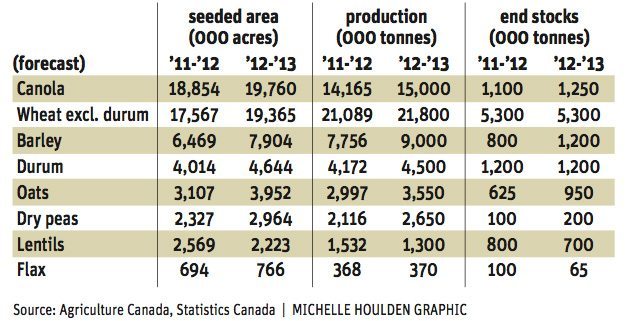When does 27 percent seem smaller than nine percent, and nine less than five?
The answer: when five, nine and 27 are the percentages that canola, wheat and oats are expected to increase this spring.
Those predictions, made by Agriculture Canada, would hit an all-time record for canola but not even get oats acreage back to what farmers intended to plant last year.
“We had such a disappointing area seeded last year,” said Fred Oleson, chief of Agriculture Canada’s economic market analysis.
The apparent surge in oats area, if it occurs, will leave the crop smaller than what farmers intended to seed last spring before floods prevented seeding in large areas of oat-heavy Manitoba and eastern Saskatchewan.
Read Also

Working groups established to address challenges in the containerized and bulk movement of commodities
CN is working with the pulse and special crops sector on resolving challenges in shipping those commodities.
In fact, the failure to reach even pre-2011 flood levels reveals oats to be one of the least inspiring crop choices for farmers this spring.
Canola, on the other hand, is forecast by Agriculture Canada to in-crease five percent to almost 20 million acres, which would be a record.
Analysts say the five percent expansion is quite a feat, considering that farmers are maxing out their crop rotations to grow more canola.
“Guys really want to grow it and they’re doing what they have to in order to grow it,” said Jon Driedger of FarmLink Marketing Solutions.
“It’s just worked out so well.”
This winter’s profitability projections have put canola and malting barley at the top and oats at the bottom. Farmers are mostly shackled to their rotations, but many have a quarter-section or two they can switch into something attractive.
The recent rally in canola prices and projections of a razor-thin carryout this year and next have helped keep canola prices and expectations high compared to many other crops.
Trade guesses of spring canola acreage range from 19.5 million to 20.5 million. Agriculture Canada’s forecast is 19.7 million, which would produce a 15 million tonne crop, or six percent more than produced in 2011, if the weather is average.
Most analysts also favour barley, which should see substantially more acres than last year. Agriculture Canada predicts a 22 percent increase, and most private analysts see at least that much and perhaps more.
Agriculture Canada sees spring wheat acres increasing by nine percent, with dryness and a return to normal growing conditions being the driving forces.
“We think they’re a little light on the barley and a little heavy on the oats,” said Driedger.
Farmers tend to favour drought-tolerant crops when the soil is as dry as it is now over much of the Prairies, which helps barley, spring wheat and durum keep and increase acres.
Oat prices have lagged the market and have made that crop the weak sister this winter.
Barley’s relative attraction comes from prices for both malting and feed barley. New crop bids in Saskatchewan of $4 per bushel will attract a lot of farmers who want a drought-tolerant, low input crop, analysts say.
Hidden in the big numbers is a desire by many farmers to grow higher-yielding, lower-quality cereal grain rather than the high-protein, high-quality grain that the Canadian Wheat Board used to encourage.
Farmers now might push for higher yields with less quality risk.
“The wheat will probably switch down to a lower-quality, higher-yielding type,” said Errol Anderson of Pro Market Communications.
Everyone acknowledges that weather conditions will play a decisive role in determining what actually goes into the ground in three months time.
“A lot depends on what moisture we get for the rest of the winter,” said Oleson.
















